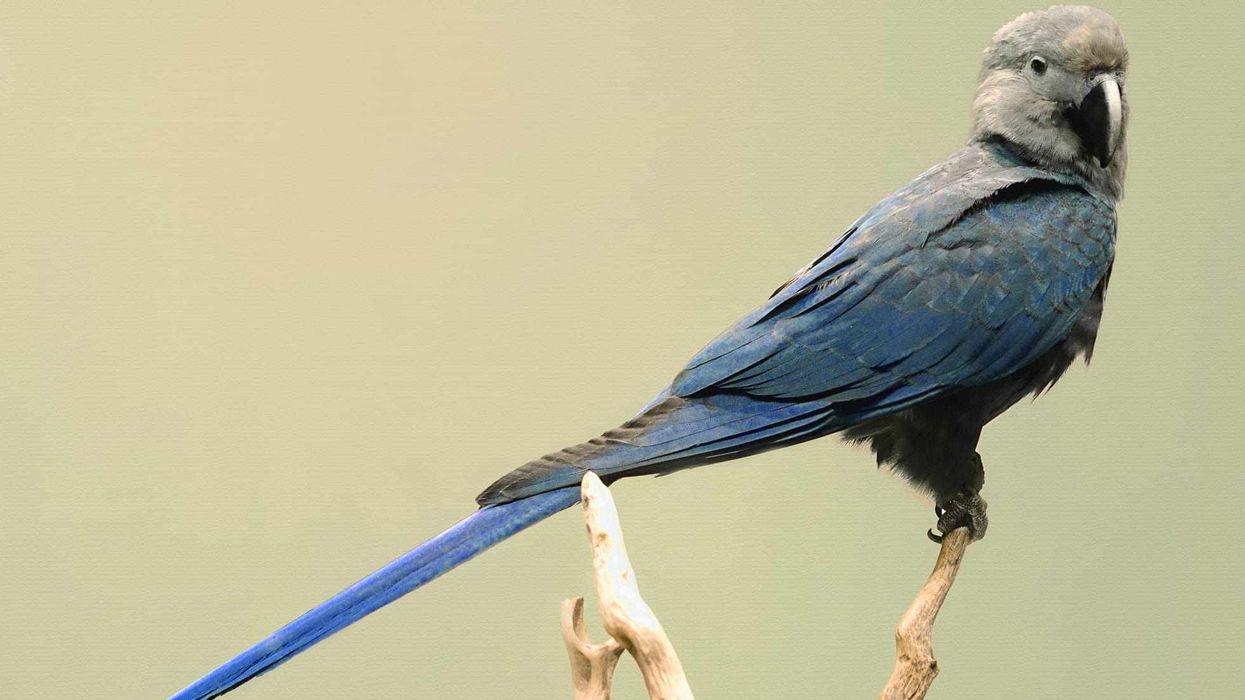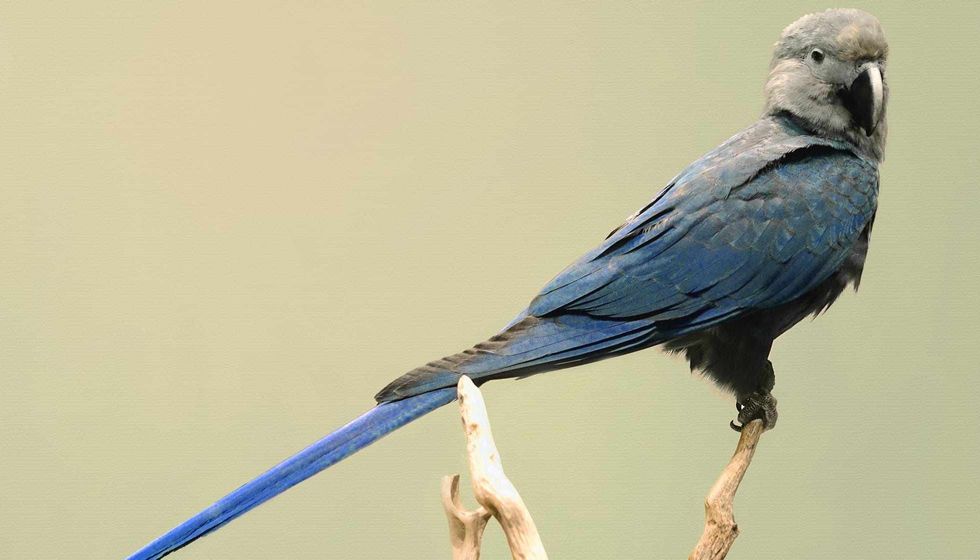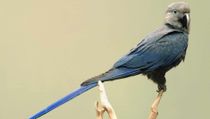Fun Spix's Macaw Facts For Kids
Content
- What type of animal is a Spix's macaw?
- What class of animal does a Spix's macaw belong to?
- How many Spix's macaws are there in the world?
- Where does a Spix's macaw live?
- What is a Spix's macaw's habitat?
- Who do Spix's macaws live with?
- How long does a Spix's macaw live?
- How do they reproduce?
- What is their conservation status?
- What do Spix's macaws look like?
- How cute are they?
- How do they communicate?
- How big is a Spix's macaw?
- How fast can a Spix's macaw fly?
- How much does a Spix's macaw weigh?
- What are their male and female names of the species?
- What would you call a baby Spix's macaw?
- What do they eat?
- Are they aggressive?
- Would they make a good pet?
- Did you know...
- How did the Spix's macaw become extinct?
- Can Spix's macaws talk?
If someone asks you to think of an animal that is colorful, talkative, and a good flyer, then what would your answer be? Of course, it would be a macaw or parrot.
And when we are talking about macaws, how can we forget about the Spix's macaws, the New World parrots. If you have watched the movie 'Rio', then you must be familiar with this bird.
A Spix’s macaw (Cyanopsitta spixii) is a distinct and wonderful bird.
This wild bird is named after a German naturalist, Johann Baptist Von Spix in 1819, as the German naturalist help in discovering the species. While Spixs macaws were listed as critically endangered earlier, now the Spix's macaws have been categorized as extinct in the wild in the IUCN Red List.
These birds are now only present in captivity. Some estimates put their total population at around 60-80 birds, but in 2016 Association for the Conservation of Threatened Parrots did a survey, where their total count was found to be around 128.
The Spix's macaw in the wild is now almost impossible to found and even in captivity they are critically endangered as their numbers are too low. Captive breeding programs are being run at various places to increase the total number of the Spix's macaws, who have undergone extinction in the wild.
After reading all the interesting information of these Brazilian parrots, you may also want to look at secretary bird facts and Gentoo penguin facts if you want to know more about birds.
Spix's Macaw Interesting Facts
What type of animal is a Spix's macaw?
A Spix's macaw (Cyanopsitta spixii) is a bird of the Psittacidae family. Macaws are the same as a parrot as they are a member of the same Psittacidae family. They can be found in the rainforests of Mexico. They are larger than a parrot.
What class of animal does a Spix's macaw belong to?
A Spix's macaw belongs to the Aves class of animals.
How many Spix's macaws are there in the world?
The population of Spix’s macaw is considered nearly extinct in the wild. The estimated number of Spix’s macaws now left in the world is 177.
The majority of these individual birds are living their lives in captivity. Captive breeding programs are now being run to restore the population of these parrots and eventually leading to reintroduction of the Spix's macaw in the wild.
Where does a Spix's macaw live?
Spix's macaws are endemic to Brazil. Now, these birds are extinct in the wild and are only to be seen in captivity.
In the year 2016, a single Spix's macaw was seen in the wild, but it was suspected that this bird had actually escaped from a captive breeding program. In Brazil, various entities such as Al Wabra Wildlife Preservation and Pairi Daiza Foundation are engaged in preserving the population of the little blue macaw which is now critically endangered.
What is a Spix's macaw's habitat?
The wild Spix’s macaw habitat is in the hottest and driest part of the Caatinga in Caraiba which is present in the Brazilian state of Bahia. Once upon a time, they used to live in areas with buriti palms groves, as they used to eat nuts growing on these palm trees.
Nevertheless, prior to the dwindling in population, these macaws were spotted in the area of Juazeiro. Juazeiro is a drab area with very few palm trees located in the northeast of Brazil and also known as Tabebuia Caraiba woodlands in the Brazilian state of Bahia.
This area has abundant plants popularly known as Caatinga. The caatinga vegetation comprises thorny bushes, cactus, different types of opuntia, and craibeira trees.
The Tabebuia caraiba woodland is a distinct natural habitat for these parrots and the reason behind this distinctiveness is the presence of three seasonal watercourses. These tree watercourses are really vital as these water sources provide the required conditions needed for the growth of the vegetation such as the craibeira trees.
The trees grow at a regular interval of 10 meters, with the caatinga vegetation surrounding these trees alongside the banks.
This vegetation pattern and watercourses combination is the most distinct and unique place for the habitat.
It would be nearly impossible to find such a habitat elsewhere in the world. The presence of such a distinct setup is the reason why Spix’s macaw found this place as best suited for their habitat.
Who do Spix's macaws live with?
The little blue macaw lives in groups known as flock or a company. There can be 10-30 individuals in a group. They travel in these small groups or companies, and together they hunt for food alongside the seasonal rivers, they make nests, and roost in treetops. For many years, no Spix's macaws have been observed in the wild.
How long does a Spix's macaw live?
The average Spix's macaw lifespan is believed to be between 20-30 years in the wild. In captivity, the macaw Spix's life span increases substantially that is why captive breeding programs are being organized to restore their lifespan.
How do they reproduce?
Spix’s macaws are monogamous birds, which means that Spix's macaw birds have one single partner only during the entire breeding season. It is said that earlier, the male of this species used to compete for mating females and securing nesting spots, but when their population became scarce, this practice of competing was dropped.
The breeding season of the wild Spix's macaws is between November and March. The Spix’s macaw is said to lay three eggs in the wild, four eggs when in captivity.
The number of eggs can range from one to seven eggs. The incubation period of these birds is 25-28 days long, and the responsibilities of all the incubation duties is on the female.
The male, during the entire incubation period, help in feeding his partner. The newly hatched chicks are born with minimal covering. The chicks can be fed by either of the parents or both.
Chicks become ready for flight in 70 days and independent in 100–130 days. The sexual maturity is obtained at the age of seven years.
What is their conservation status?
The conservation status of the Spix's macaw is mentioned as extinct in the wild. The captive population of this species is only 177 Spix's macaws left in the world.
Captive breeding program has been taken up in Qatar, Brazil and Germany. It is a threatened species that was exploited for pet trade and for many years now has been known to exist only in captivity.
Spix's Macaw Fun Facts
What do Spix's macaws look like?
Spix's macaw or a little blue macaw, is the only little blue macaw with a dark grey-colored face. It is the smallest blue macaw, and its body is covered with feathers of dark blue color.
The face of a Spix's macaw is grey colored and has a long black curved beak. The skin around their eyes is also grey, and the eyes are pale yellow in color. From the body extends a long tail which is pointed at the end.
The tail is dark blue on its top and grey on the underside. Both the male and female macaws have similar colors of their bodies.
The Spix's macaw is almost 22 in tall with a tail length of 10-15 in. The wingspan of a Spix's macaw is 9.7–11.8 in. In the wild, the Spix’s macaws are inactive, and only in the daytime, it is seen as active or mobile.

*Please note that this is an image of an African grey parrot from the same family Psittacidae, not a Spix's Macaw specifically. If you have an image of a Spix's Macaw, then please let us know at hello@kidadl.com.
How cute are they?
If a Spix's macaw is to be rated on the basis of its cuteness, then it will surely get 10 out of 10. The Spix's macaw has a distinct body color which makes them look so adorable. Moreover, their unique ability to mimic and speak like humans makes them one of the most interesting creatures alive on this earth.
How do they communicate?
In order to communicate, Spix's macaw makes loud calls, squawks, and screams that echo through the forest canopy. And in order to mark their territory and identify one another, they use different tones. Some species of wild Spix's macaws can even mimic and speak like humans.
How big is a Spix's macaw?
A Spix's macaw is approximately 22 in tall, which means that it is almost five times bigger than a hummingbird.
How fast can a Spix's macaw fly?
The Spix's macaw are really fast flyers and they can fly at an impressive speed of around 38 mph.
How much does a Spix's macaw weigh?
The Spix's macaw range of weight is 0.8-1.0 lb. Their light weight allows them to fly at a faster pace and can be seen flying high in the sky.
What are their male and female names of the species?
A male Spix's macaw is called a cock, and female Spix's macaw is called a hen.
What would you call a baby Spix's macaw?
A baby Spix's macaw is known as a chick. The newly hatched chicks are born with minimal covering. The chicks can be fed by either of the parents or both.
The chicks become ready for flight in 70 days and independent in 100–130 days. The sexual maturity is obtained at the age of seven years.
What do they eat?
Sprix's macaws are usually herbivores but when living in captivity then they are also given some non-vegetarian food items, which indicates that Sprix's macaws can also be omnivores. In the wild they eat seeds, fruits, flowers, leaves and other plant material. The Spix's macaw birds also feed on tree bark which helps them to obtain essential minerals.
Spix's macaw captivity diet comprises seeds of safflower, hemp, sunflower, wheat, and oats. Apart from seeds, they are fed with nuts, fruits, vegetables, green food, soaked pigeon food, Small amounts of pre-cooked beef, good quality avian vitamins and mineral supplements, tree bark and cactus meat.
Are they aggressive?
Yes, sometimes these birds can be aggressive. The Spix's macaw do not like to be ignored, and if they feel they are being avoided and ignored they can become rude and harsh. If they feel angry or irritated, then they can bite and injure other animals and humans with their strong beaks.
Would they make a good pet?
Macaw's can indeed make a good pet. These colorful and clownish birds are very famous pet bird species. In the beginning, they might be tough to deal with but they are highly social birds and they can build a strong bond with their owners’ overtime.
Did you know...
Yes, macaws can live together. They do not trouble much when they are kept with another macaw.
They can quickly learn to make a peaceful and friendly bond with their other fellow macaw. When these birds used to live in the wild, they had groups of 10-30 individuals. And this clearly indicates that they are social birds and are not against having a fellow macaw on its side.
As the blue Spix's macaw IUCN Red List status was critically endangered, the Spix's macaw price skyrocketed in the black market. Spix's macaw value skyrocketed to above $40,000. With Spix's macaw extinct status in the wild, it is entirely illegal to have the Spix's macaw as a pet since many year.
How did the Spix's macaw become extinct?
The Spix's macaw population declined heavily over the past few decades, and many reasons contributed to it.
The first reason was that these birds were endemic to Brazil and this place was their natural habitat, but the decades of exploitation in the Bahia region of Brazil resulted in the loss of their natural habitats. From this point onwards their population started to decline heavily.
The problem worsened, even more when these birds were trapped for trade in the black market.
Some other factors that may have contributed to this steep decline in their population were the African bee colonization in the region and the construction of dams. The last known wild Spix's macaw is said to be seen in 2000.
The Brazilian government with the help of ICMBio (Chico Mendes Institute for Biodiversity Conservation) is now running a breeding program through artificial insemination for preventing Spix's macaw from going extinct.
Can Spix's macaws talk?
Yes, Spix's macaws can talk. These birds are very clownish and intelligent at the same time. They are experts in mimicking and speaking like a human. If they are trained adequately, then they can very easily speak just like a human.
Here at Kidadl, we have carefully created lots of interesting family-friendly animal facts for everyone to discover! Learn more about some other birds including great green macaw, or tawny owl.
You can even occupy yourself at home by drawing one on our Spix's Macaw coloring pages.
We Want Your Photos!
More for You
See All
Bachelors in Business Administration

Aashita DhingraBachelors in Business Administration
Based in Lucknow, India, Aashita is a skilled content creator with experience crafting study guides for high school-aged kids. Her education includes a degree in Business Administration from St. Mary's Convent Inter College, which she leverages to bring a unique perspective to her work. Aashita's passion for writing and education is evident in her ability to craft engaging content.
Disclaimer
1) Kidadl is independent and to make our service free to you the reader we are supported by advertising. We hope you love our recommendations for products and services! What we suggest is selected independently by the Kidadl team. If you purchase using the Buy Now button we may earn a small commission. This does not influence our choices. Prices are correct and items are available at the time the article was published but we cannot guarantee that on the time of reading. Please note that Kidadl is a participant in the Amazon Services LLC Associates Program, an affiliate advertising program designed to provide a means for sites to earn advertising fees by advertising and linking to Amazon. We also link to other websites, but are not responsible for their content.
2) At Kidadl, we strive to recommend the very best activities and events. We will always aim to give you accurate information at the date of publication - however, information does change, so it’s important you do your own research, double-check and make the decision that is right for your family. We recognise that not all activities and ideas are appropriate for all children and families or in all circumstances. Our recommended activities are based on age but these are a guide. We recommend that these ideas are used as inspiration, that ideas are undertaken with appropriate adult supervision, and that each adult uses their own discretion and knowledge of their children to consider the safety and suitability. Kidadl cannot accept liability for the execution of these ideas, and parental supervision is advised at all times, as safety is paramount. Anyone using the information provided by Kidadl does so at their own risk and we can not accept liability if things go wrong.
3) Because we are an educational resource, we have quotes and facts about a range of historical and modern figures. We do not endorse the actions of or rhetoric of all the people included in these collections, but we think they are important for growing minds to learn about under the guidance of parents or guardians.




